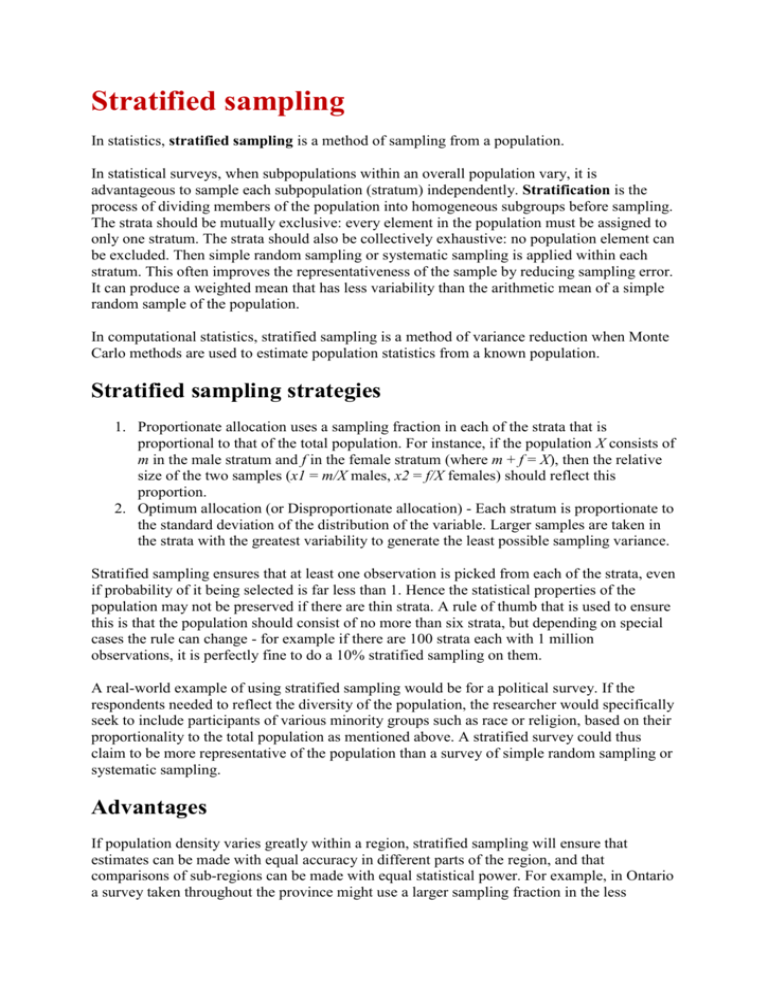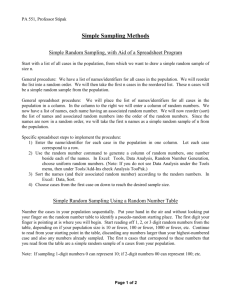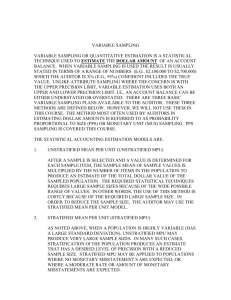Stratified sampling
advertisement

Stratified sampling In statistics, stratified sampling is a method of sampling from a population. In statistical surveys, when subpopulations within an overall population vary, it is advantageous to sample each subpopulation (stratum) independently. Stratification is the process of dividing members of the population into homogeneous subgroups before sampling. The strata should be mutually exclusive: every element in the population must be assigned to only one stratum. The strata should also be collectively exhaustive: no population element can be excluded. Then simple random sampling or systematic sampling is applied within each stratum. This often improves the representativeness of the sample by reducing sampling error. It can produce a weighted mean that has less variability than the arithmetic mean of a simple random sample of the population. In computational statistics, stratified sampling is a method of variance reduction when Monte Carlo methods are used to estimate population statistics from a known population. Stratified sampling strategies 1. Proportionate allocation uses a sampling fraction in each of the strata that is proportional to that of the total population. For instance, if the population X consists of m in the male stratum and f in the female stratum (where m + f = X), then the relative size of the two samples (x1 = m/X males, x2 = f/X females) should reflect this proportion. 2. Optimum allocation (or Disproportionate allocation) - Each stratum is proportionate to the standard deviation of the distribution of the variable. Larger samples are taken in the strata with the greatest variability to generate the least possible sampling variance. Stratified sampling ensures that at least one observation is picked from each of the strata, even if probability of it being selected is far less than 1. Hence the statistical properties of the population may not be preserved if there are thin strata. A rule of thumb that is used to ensure this is that the population should consist of no more than six strata, but depending on special cases the rule can change - for example if there are 100 strata each with 1 million observations, it is perfectly fine to do a 10% stratified sampling on them. A real-world example of using stratified sampling would be for a political survey. If the respondents needed to reflect the diversity of the population, the researcher would specifically seek to include participants of various minority groups such as race or religion, based on their proportionality to the total population as mentioned above. A stratified survey could thus claim to be more representative of the population than a survey of simple random sampling or systematic sampling. Advantages If population density varies greatly within a region, stratified sampling will ensure that estimates can be made with equal accuracy in different parts of the region, and that comparisons of sub-regions can be made with equal statistical power. For example, in Ontario a survey taken throughout the province might use a larger sampling fraction in the less populated north, since the disparity in population between north and south is so great that a sampling fraction based on the provincial sample as a whole might result in the collection of only a handful of data from the north. Randomized stratification can also be used to improve population representativeness in a study. Disadvantages Stratified sampling is not useful when the population cannot be exhaustively partitioned into disjoint subgroups. It would be a misapplication of the technique to make subgroups' sample sizes proportional to the amount of data available from the subgroups, rather than scaling sample sizes to subgroup sizes (or to their variances, if known to vary significantly e.g. by means of an F Test). Data (at the same time) to the subgroups' sizes within the total population. For an efficient way to partition sampling resources among groups that vary in their means, their variances, and their costs, see "optimum allocation". The problem of stratified sampling in the case of unknown class priors (ratio of subpopulations in the entire population) can have deleterious effect on the performance of any analysis on the dataset, e.g. classification. In that regard, minimax sampling ratio can be used to make the dataset robust with respect to uncertainty in the underlying data generating process. Practical example In general the size of the sample in each stratum is taken in proportion to the size of the stratum. This is called proportional allocation. Suppose that in a company there are the following staff: male, full-time: 90 male, part-time: 18 female, full-time: 9 female, part-time: 63 Total: 180 and we are asked to take a sample of 40 staff, stratified according to the above categories. The first step is to find the total number of staff (180) and calculate the percentage in each group. % male, full-time = 90 ÷ 180 = 50% % male, part-time = 18 ÷ 180 = 10% % female, full-time = 9 ÷ 180 = 5% % female, part-time = 63 ÷ 180 = 35% This tells us that of our sample of 40, 50% should be male, full-time. 10% should be male, part-time. 5% should be female, full-time. 35% should be female, part-time. 50% of 40 is 20. 10% of 40 is 4. 5% of 40 is 2. 35% of 40 is 14. Another easy way without having to calculate the percentage is to multiply each group size by the sample size and divide by the total population size (size of entire staff): male, full-time = 90 × (40 ÷ 180) = 20 male, part-time = 18 × (40 ÷ 180) = 4 female, full-time = 9 × (40 ÷ 180) = 2 female, part-time = 63 × (40 ÷ 180) = 14









